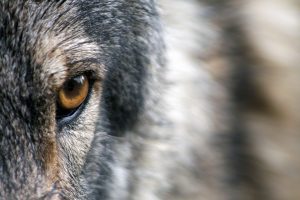
Washington’s wolf population grew at a slow pace last year but did reach new highs for overall numbers, packs and breeding pairs, according to a news release from the Washington Department of Fish and Wildlife.
The uptick includes the newly documented Butte Creek pack in the upper end of the Wenaha drainage in the Blue Mountains. There are now four packs in the Washington portion of the Blues.
The report indicates there are 126 wolves in Washington, 27 packs and 15 breeding pairs. That is up from 122 wolves in 2017, 22 packs and 14 breeding pairs. A breeding pair is comprised of one adult male and one female that raise at least two pups who survive through the calendar year.
For the first time, the state documented a wolf pack west of the Cascade Mountains. According to the news release, a single male wolf that was captured in Skagit County and fitted with a radio collar in 2016 has been traveling with a female through the winter. The pair is being called the Diobsud Creek pack.
“We’re pleased to see our state’s wolf population continue to grow and begin to expand to the west side of the Cascades,” said Kelly Susewind, director of the Washington Department of Fish and Wildlife at Olympia. “We will continue to work with the public to chart the future management of this important native species.”
The actual report has not yet be released to the public. The news release said the report will be available on the agency’s website today after it is reviewed by the Washington Fish and Wildlife Commission at its meeting in Olympia.
Despite the slow growth rate, just over 3 percent, state wildlife officials say the increase in packs and breeding pairs is likely to lead to more growth in the future.
“Packs and breeding pairs are the building blocks of population growth,” said Donny Martorello, wolf policy leader for the department at Olympia. “It’s reassuring to see our wolf population occupying more areas of the landscape.”
Jay Holzmiller, a Washington Fish and Wildlife Commissioner from Anatone, said the report represents a minimum population estimate.
“That can’t be conveyed enough,” he said. “It truly is a bare minimum.”
Wildlife managers recorded 12 wolf deaths during 2018. Six wolves were legally killed by tribal hunters, four were killed by Washington Fish and Wildlife officials in response to repeated wolf-caused livestock deaths, and two other deaths appear to have been caused by humans and remain under investigation.
Five packs were involved in at least one livestock depredation. According to the news release, at least 11 cattle and one sheep were killed, and 19 cattle and two sheep were injured by wolves. The state paid out $7,536 to ranchers in five damage claims and paid $5,950 to one producer for reduced weight gains in cattle associated with the presence of wolves.
Wolves were extirpated from Washington in the 1930s. The animals began to recolonize the state in 2008, when wolves from Idaho and British Columbia moved into Okanogan County in the state’s northeastern corner.
Wolves are protected as threatened under the Washington Endangered Species Act and they are federally protected in the western two-thirds of the state.
“The state’s wolf management plan lays out a variety of recovery objectives, but the ultimate determination of a species’ listing status is whether it remains at risk of failing or declining,” Martorello said.
Source: Numbers of wolves slowly growing in Washington | Northwest | lmtribune.com